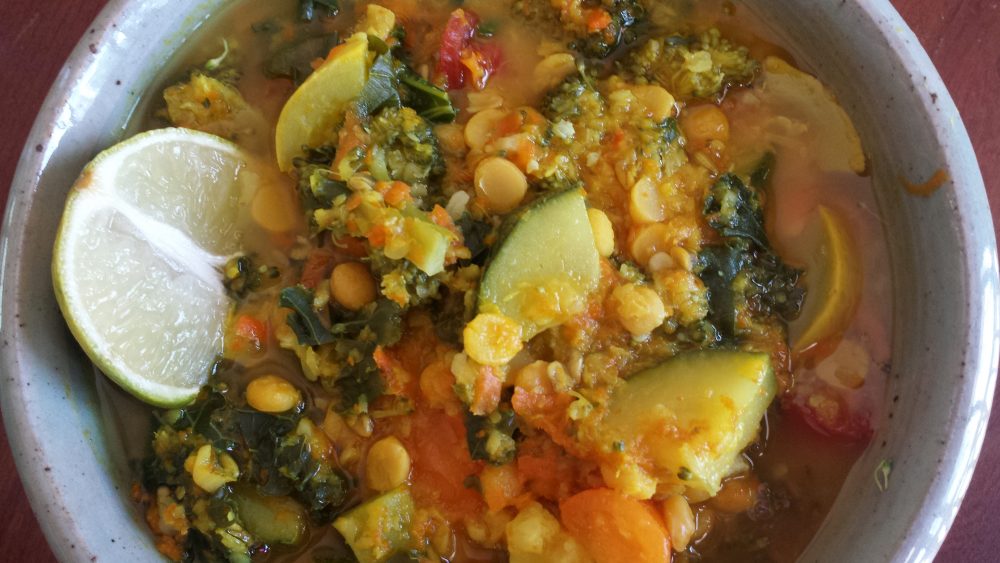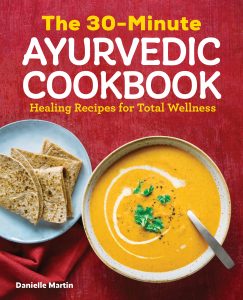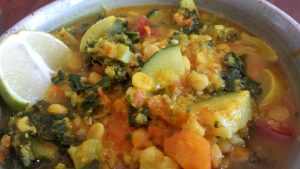 If you have not heard of chana dal before, it is the chick pea (garbanzo bean), split in half with the skin removed. This recipe blends chana dal along with mung dal (the yellow split mung bean), creating an amazing flavor, texture, and incredibly long list of nutrients and health benefits. Since many individuals are trying to reduce their grain consumption, this recipe is a great option, as I have added a long list of colorful veggies that will make you forget grains are even missing. Of course if you love your basmati rice (or quinoa!), this dal recipe can easily (and deliciously) be served over a healthy grain of your choice!
If you have not heard of chana dal before, it is the chick pea (garbanzo bean), split in half with the skin removed. This recipe blends chana dal along with mung dal (the yellow split mung bean), creating an amazing flavor, texture, and incredibly long list of nutrients and health benefits. Since many individuals are trying to reduce their grain consumption, this recipe is a great option, as I have added a long list of colorful veggies that will make you forget grains are even missing. Of course if you love your basmati rice (or quinoa!), this dal recipe can easily (and deliciously) be served over a healthy grain of your choice!
Although this recipe can be eaten anytime, it is a bit more specific for the summer or springtime, as the veggies listed are seasonally grown, and the overall energetic of the meal is cooling. Being cooling, it is a great recipe option for Pitta types. However being grain-free, fiber packed and filled with healthy lean protein, this recipe is equally as beneficial for Kapha types (and weight loss therapies!). Vata individuals can partake, although chana dal may produce excessive gas in some Vata types. In these cases the chana dal should be replaced with mung dal, which tends to be easier to digest.
Health benefits of this recipe include:
- High in multiple nutrients such as protein, iron, calcium, potassium, magnesium, folate, copper, zinc, and various B vitamins
- Great source of dietary fiber
- Reduces appetite levels by keeping you full longer (great meal option for weight loss programs!)
- High in cancer-fighting, anti-aging antioxidants
- Cooling recipe perfect for late spring, summer, and during Pitta imbalances (omit the tomatoes)
- Uses a wide variety of fresh, colorful, seasonal vegetables
- Balances blood sugar levels and reduces insulin resistance
- Improves heart health, reduces cholesterol levels
- Improves colon health and promotes healthy elimination
- Spices involved provide numerous health benefits such as reducing inflammation, flushing toxins, increasing circulation, boosting immunity, increasing the digestion and allowing better absorption of nutrients (see a full list of health benefits for these and other kitchen spices here)
Deliciously Vibrant Chana and Mung Dal Recipe
Click here for a printable copy of this recipe.
- Doshic effect: Vata↓*, Pitta↓, Kapha↓
- Serves: 2 to 3
- Prep Time: 5 minutes
- Cook Time: 55 minutes
- Gluten-Free, Vegetarian (can be made Vegan)
*Vata types should replace the chana dal with extra mung dal if gas or bloating occur.
Materials
- Large sauce pan
- Cutting board and knife
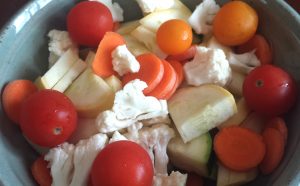
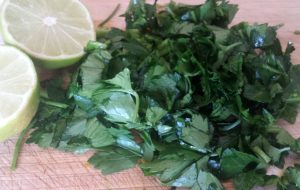
Ingredients
- 1 tablespoon ghee or coconut oil
- 1/2 teaspoon cumin seed, whole
- 1/2 teaspoon coriander powder*
- 1/2 teaspoon fennel seed, whole*
- 1/8 teaspoon freshly ground black pepper
- 1 teaspoon turmeric powder*
- 1 tablespoon fresh ginger, finely grated
- 2 tablespoons shredded coconut (omit for Kapha)
- 6 cups water
- 1/2 cup chana dal, soaked overnight (I recommend the Organic Tattva brand)
- 1/2 cup mung dal, soaked overnight
- 1/2 cup chopped zucchini
- 1/2 cup chopped yellow squash
- 1/2 cup chopped cauliflower
- 1/2 cup chopped broccoli
- 1/2 cup chopped kale
- 1/4 cup sliced carrots
- 4 to 5 cherry tomatoes, sliced in half (omit for Pitta and Vata)
- 1/4 cup chopped cilantro
- 1 lime, juiced
- 1/2 teaspoon pink Himalayan salt (more or less to taste)
*These spices can be replaced with 2 teaspoons of Agni Churna or Pitta Churna
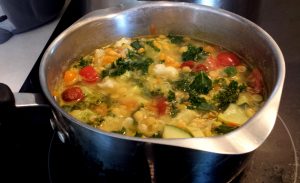
Click here for a printable copy of this recipe.
Directions
1. Place one tablespoon of ghee or coconut oil in a large sauce pan over medium heat. Once hot, add in the cumin seed, coriander powder, fennel seed, and black pepper (or replace with Agni Churna or Pitta Churna). Stirring frequently, sauté the spices for about 2 minutes allowing them to slightly roast without burning. Add in the turmeric, ginger, and coconut and sauté for an additional 30 seconds.
2. Add in the water and turn the heat to high until the water comes to a boil.
3. Once boiling, reduce the heat to low-medium and add in the chana dal and mung dal. Cook here for 30 minutes keeping the pot covered, leaving a small crack to avoid overflow. Stir every 10 minutes.
4. While the beans are cooking, begin to wash and chop the zucchini, squash, cauliflower, broccoli, kale, carrots, and cherry tomatoes.
5. After the 30 minutes has passed add in the chopped vegetables. Continue to cook at a low-medium temp for an additional 10 minutes, keeping the pot covered and leaving a small crack to avoid overflow. Stir every 5 minutes.
6. After 10 minutes, turn the heat to low and cook for 5 to 10 minutes. Stir every 3 to 5 minutes.
7. Check to see if everything is at a good texture. The beans should be soft and mushy but not overcooked. The veggies should be soft, yet still vibrant in color.
8. If there is any hardness left, continue to cook for as long as needed to acquire the desired soft consistency, checking every 3 minutes to avoid overcooking. Cooking the beans and veggies to a softer texture allows for easier digestion.
9. Once the desired consistency has been reached, turn off the heat, but leave the pan on the hot burner. Add in the cilantro, fresh lime juice, and salt and blend well.
10. This dal recipe is a great meal all in itself and can simply be served as is for a tasty, delicious, and filling grain-free meal. However, other options include serving it over a small portion of basmati rice or quinoa (or any grain of choice), or eating the dal with a side of chapati, roti, dosa, or bread of choice. Whichever you may choose, eat, enjoy, and share with loved ones!
ADDITIONAL TIPS
- Garnish each bowl with some additional chopped cilantro, shredded coconut, and ghee for a beautiful look and even better taste!
- During the fall or winter season, warm it up a bit with brown mustard seed, dry ginger (instead of fresh), extra black pepper, a small spoonful of tahini (yum!), sesame oil (instead of ghee), and/or a cinnamon stick or two.
- If the listed vegetables are not available, replace with some veggies that are. Make sure to use a wide variety with multiple colors and to use seasonal options (i.e. root veggies in the fall, asparagus in the spring, etc).
- If the chana dal creates gas or bloating replace them with extra mung dal.
- Serve over basmati rice, brown rice, quinoa, millet, buckwheat groats, or any grain of choice if desired.
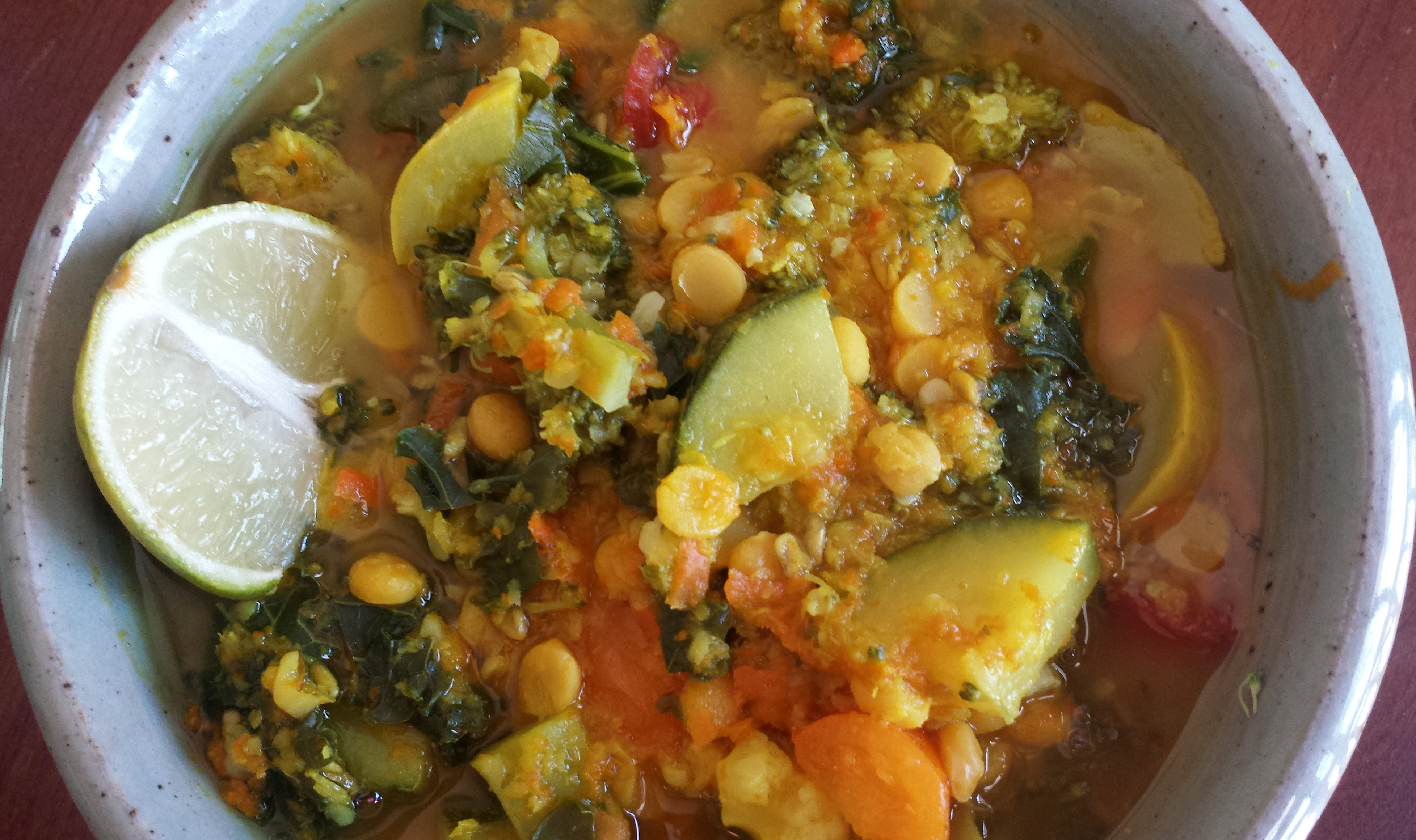
Discover more healing recipes with my 30-Minute Ayurvedic Cookbook!

